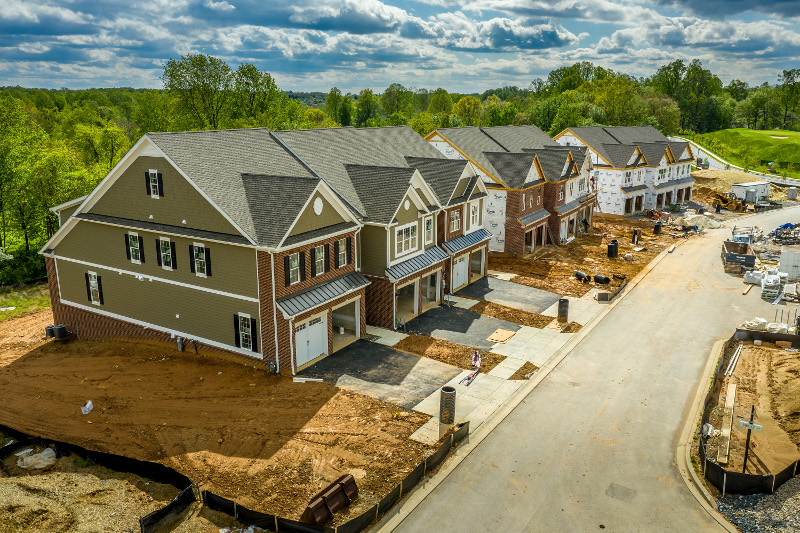You are viewing our site as an Agent, Switch Your View:
Agent | Broker Reset Filters to Default Back to ListWhen Will U.S. Buyers See Relief From Skyrocketing Home Prices?
June 20 2021
Home prices usually follow the laws of supply and demand: when demand is strong, supply diminishes, and prices rise, creating an incentive for owners to sell and builders to build. As the supply of homes for sale increases, those high prices moderate or decline. But, on a year-over-year basis, U.S. home prices have increased for an astounding 110 months straight; and since the pandemic began, they've risen at an extraordinary pace. Just this past April, the median home sales price in the U.S. was $341,600, nearly 20% higher than the year before. So when can buyers expect to see some much-needed home price relief?
Too Much Demand, Not Enough Supply
The issue with the law of supply and demand lately has been…well…not enough supply and too much demand, especially surrounding new home builds. Builders can't keep up with new home demand due to shortages of materials and appliances, along with skilled labor. Lumber prices alone are more than 250% higher than last year, and are adding nearly $36,000 to the average cost of a new build. The extreme supply shortages have driven up the median price of new homes to $372,400, the most substantial annual gain since 1988, when prices rose 87% in one year.

New home builds aside, we're also seeing two of the largest generations in history — millennials, and Generation Zers, reach homebuying age and ability. More than 80% of millennials plan to buy a home at some point in their lives, and last year, 39% of all homebuyers were younger than 40.
Mortgage rates below 3% ignited the generational pressure to purchase, and home sales surged to the highest level since 2006, despite pandemic challenges. Record sales quickly drained available inventories, and by the end of 2020, supplies of homes for sale were the lowest since 1999, when the National Association of Realtors first kept inventory records Now, inventory is so low and prices so high that sales are finally starting to slow, falling for the third straight month in April.
(READ MORE: How Are Sellers in the Current Market REALLY Doing?)
Can the Drought Get Any Worse?
Even though record numbers of millennials are entering the market, it's not a journey some want to take with seemingly no home price relief in sight. Buying a first home is so expensive today that nearly one out of five prospective millennial buyers say they are giving up on homeownership and plan to rent for the rest of their lives. Will their sitting out the market help ease inventories? Not likely, at least not right now.
There's no sign that the laws of supply and demand can restore balance to the real estate economy any time soon, and it may be just a matter of time until the inventory drought shuts sales down to a trickle. Still, there are some positive signs that demand will decrease and supplies will increase enough to bring some home price relief:
Mortgage Rates Should Increase, Tempering Demand-driven Price Hikes
Home price relief won't happen until mortgage interest rates rise and home supplies improve. For two years, forecasters and mortgage companies have said that higher rates are just around the corner. This year, they may be right.
Inflation is suddenly surging for the first time in decades, and Fannie Mae's economists predict housing could contribute more than two percentage points to inflation by the end of 2022. The forecasted rates on a 30-year fixed mortgage will reach 3% by mid-year and stay above 3% through 2022. The Mortgage Bankers Association sees rates reaching 3.5% by the end of 2021, and 4% in the second quarter next year.
New Home Starts Are Up
The inventory of previously owned homes reached record lows in April, but on a year-over-year basis, housing starts (new homes being built) in March surged to a nearly a 15-year high, and April starts were 67.3% higher than they were in April 2020. Fannie Mae forecasts an aggressive 16.3% increase in single-family home construction this year over 2020, but that increase in new homes amounts to about 2.4% of demand — far below what is needed to meet it.
As Price Appreciation Slows, Sellers Will Become More Motivated
Just as the fear of higher mortgage rates motivated buyers in 2020, the fear of falling prices driven by rising rates will motivate sellers. As a result, listings may begin to increase on a year-over-year basis in the first quarter of 2022, when sellers prepare for the spring sales season.
Baby Boomers, who own 41% of the nation's homes, have been much slower than earlier generations to downsize as they age. Millions of Boomer homeowners lost more than a decade of appreciated equity after the housing crash in 2007, and many are waiting until prices peak to sell and regain as much equity as possible.

In last year's price boom, older Baby Boomers sold their homes at a higher rate than any other age group. When it's clear that the current boom has run its course, more Boomers will be listing their homes for sale.
The Experts Forecast Significant Changes in Prices by 2022
Economists at Fannie Mae and Freddie Mac and several of the best real estate data and analytics firms forecast changes in market trends two years in advance.
As of May, Fannie Mae forecasted that the median national price will rise 9.5% for new homes this year but only 4.4% in 2022. Home prices will continue to grow at 12.2% this year and 3.9% next year for existing homes. As of April, Freddie Mac forecasted that the price boom would end this year. Freddie's experts forecasted that all home prices, new and existing, will increase only 6.6% this year―a decline from 11.3% in 2020―and 4.4% in 2022.
The respected real estate analytics firm CoreLogic agrees that home price increases will slow down this year, reporting that median year-over-year national price increase will fall to 2.8% by April 2022.

Lawrence Yun, chief economist at the National Association of Realtors, also agrees. "We'll see more inventory come to the market later this year as further COVID-19 vaccinations are administered and potential home sellers become more comfortable listing and showing their homes," said Yun. "In addition, the falling number of homeowners in mortgage forbearance will also bring about more inventory."
"Despite the decline, housing demand is still strong compared to one year ago, evidenced by home sales from this January to April, which are up 20% compared to 2020. Moreover, the additional supply projected for the market should cool down the torrid pace of price appreciation later in the year," Yun said.
The Bottom Line
Mortgage interest rates are the critical factor driving housing demand. It's more than likely that by the end of this year, rates could drive upwards of 4% or higher. Sellers, led by Boomers eager not to miss the price peak, will bring a modicum of relief to the inventory shortage.
In 12 months, the rate of price appreciation for single-family homes will be half its current rate of 19.1%, if not lower. By then, inventories will improve but won't return to healthy levels until pent-up demand is met and new home construction makes a more significant contribution. So while we can't expect to see home prices fall, we can expect their increases to slow down significantly.
Steve Cook is the editor of the Down Payment Report and provides public relations consulting services to leading companies and non-profits in residential real estate and housing finance. He has been vice president of public affairs for the National Association of Realtors, senior vice president of Edelman Worldwide and press secretary to two members of Congress.
To view the original article, visit the Homes.com blog.









